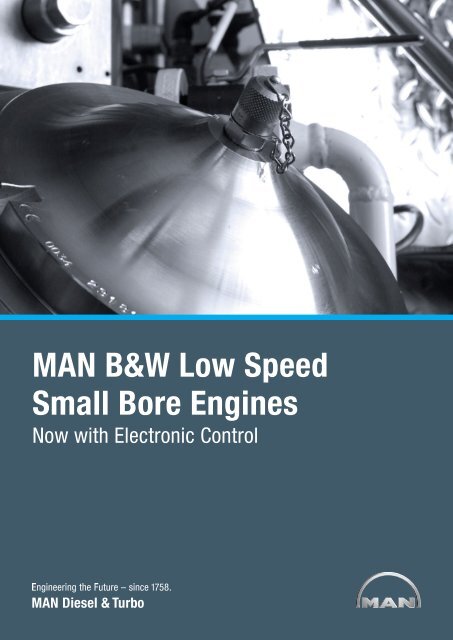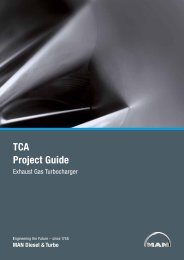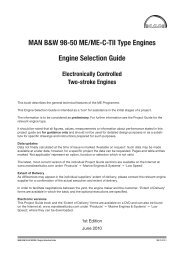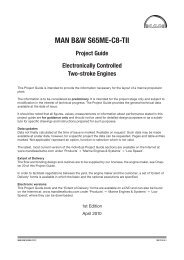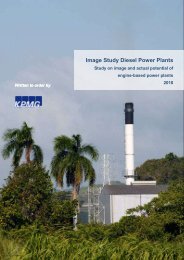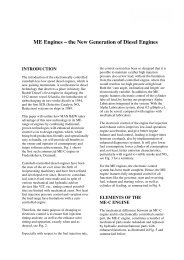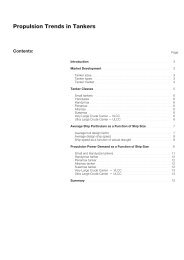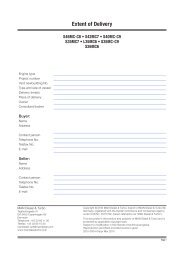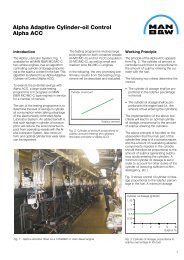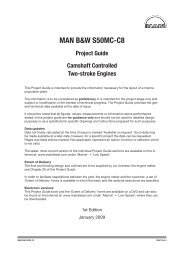MAN B&W Low Speed Small Bore Engines - MAN Diesel & Turbo
MAN B&W Low Speed Small Bore Engines - MAN Diesel & Turbo
MAN B&W Low Speed Small Bore Engines - MAN Diesel & Turbo
Create successful ePaper yourself
Turn your PDF publications into a flip-book with our unique Google optimized e-Paper software.
<strong>MAN</strong> B&W <strong>Low</strong> <strong>Speed</strong><br />
<strong>Small</strong> <strong>Bore</strong> <strong>Engines</strong><br />
Now with Electronic Control
Contents<br />
<strong>MAN</strong> B&W <strong>Diesel</strong><br />
Introduction .................................................................................................5<br />
Engine data ............................................................................................7<br />
Engine comparison .................................................................................8<br />
ME-B fuel injection control system .............................................................. 10<br />
Injection performance ........................................................................... 10<br />
Engine control system ........................................................................... 10<br />
Engine Design S35/40/50ME-B .................................................................. 11<br />
Bedplate, framebox and cylinder frame ................................................. 12<br />
Crankshaft ............................................................................................ 13<br />
Connecting rod ..................................................................................... 14<br />
Bearings ............................................................................................... 14<br />
Combustion chamber ........................................................................... 15<br />
Cylinder liner ......................................................................................... 15<br />
Piston ................................................................................................... 15<br />
Exhaust valve ....................................................................................... 16<br />
Fuel injection equipment ....................................................................... 17<br />
Thrust bearing ...................................................................................... 18<br />
Engine control system ........................................................................... 18<br />
<strong>Turbo</strong>charger and air cooler arrangement .............................................. 19<br />
Concluding Remarks .................................................................................. 19<br />
<strong>MAN</strong> B&W <strong>Low</strong> <strong>Speed</strong> <strong>Small</strong> <strong>Bore</strong> <strong>Engines</strong> Now with Electronic Control<br />
3
<strong>MAN</strong> B&W <strong>Low</strong> <strong>Speed</strong> <strong>Small</strong> <strong>Bore</strong> <strong>Engines</strong><br />
Now with Electronic Control<br />
Introduction<br />
The <strong>MAN</strong> B&W 35MC engine was<br />
launched in 1982 as the L35MC with<br />
500 kW/cylinder and a mean effective<br />
pressure of 14.8 bar at 200 rpm. Sev-<br />
eral design updates, often combined<br />
with a power up, have been introduced<br />
since then, and with today’s Mark 6 rat-<br />
ing, the power per cylinder is 650 kW/<br />
cylinder with a mean pressure of 18.4<br />
bar at 210 rpm.<br />
To meet the market demand for lower<br />
propeller speed, and thereby higher<br />
propulsion efficiency, the long-stroke<br />
S35MC (see Fig. 1) was launched in<br />
1993 with 170 rpm and a mean pres-<br />
sure of 18.4 bar, resulting in 700 kW/<br />
cylinder.<br />
Since then, the S35MC engine has<br />
been extensively used in the propulsion<br />
of a wide variety of vessels ranking in<br />
sizes from 5,000 to 25,000 dwt.<br />
To cater for the increasing market de-<br />
mand for higher power, an uprated ver-<br />
sion of the S35MC was introduced in<br />
1998 with a mean effective pressure<br />
of 19.1 bar at 173 rpm, thus providing<br />
740 kW/cylinder.<br />
The market also required direct coupled<br />
two-stroke engines in the 5-10,000 kW<br />
output area. The S42MC was therefore<br />
introduced with 136 rpm with a cylinder<br />
power of 995 kW/cylinder at a mean ef-<br />
fective pressure of 18.5 bar.<br />
Based on an increasing market demand<br />
for higher-powered super long-stroke<br />
small bore engines, the S42MC was up-<br />
rated in 1999. The mean effective pres-<br />
sure was increased to 19.5 bar at 136<br />
rpm, thus providing 1,060 kW/cylinder.<br />
<strong>MAN</strong> B&W <strong>Diesel</strong><br />
Since the delivery of the first L35MC in<br />
1982, a total of ~1,000 L35MC, ~500<br />
S35MC, ~200 L42MC and ~250 S42MC<br />
engines are on order or have been de-<br />
livered. More than 1,000 S50MC-C has<br />
been delivered since 1997.<br />
The above-mentioned small bore two-<br />
stroke engines have been the world<br />
leaders in their market segment for<br />
decades. However, the market is al-<br />
Fig. 1: <strong>MAN</strong> B&W S35MC cross section<br />
ways moving, and requirements for<br />
more competitive engines, i.e. the low-<br />
est possible propeller speed, lower fuel<br />
consumption, lower lube oil consump-<br />
tion and more flexibility regarding emis-<br />
sion and easy adjustment of the engine<br />
parameters, call for a re-evaluation of<br />
the design parameters, engine control<br />
and layout.<br />
<strong>MAN</strong> B&W <strong>Low</strong> <strong>Speed</strong> <strong>Small</strong> <strong>Bore</strong> <strong>Engines</strong> Now with Electronic Control<br />
5
Our marketing investigation into this<br />
segment, including scrutinising the<br />
power against propeller speed for tank-<br />
ers, containers and bulkers, has shown<br />
that a 35 cm bore engine with a slightly<br />
reduced speed and a higher engine<br />
power will suit well. In the segment for<br />
the S42MC type, a 40 cm bore engine<br />
with 146 rpm will, together with an up-<br />
dated 35 cm bore engine, cover the<br />
required output area between the S35<br />
and the S46MC-C very well,<br />
The continuous development of mer-<br />
chant ships to be even more efficient<br />
is never ending. The aft body of the<br />
ships for example may be designed to<br />
fit even larger propellers, which again<br />
have a higher propeller efficiency, but a<br />
lower optimum propeller speed.<br />
As the two-stroke main engine is nor-<br />
mally coupled directly to the propeller,<br />
thereby avoiding the reduction gear<br />
and its loss of efficiency, the design of<br />
modern main engines has to be based<br />
on a continuously lower engine speed<br />
(r/min).<br />
With the new S50ME-B, which will be<br />
designated Mk 9, we have introduced<br />
a competitive engine designed for new<br />
modern hull designs, based on more<br />
efficient propellers with a lower opti-<br />
mum propeller speed. The engine will<br />
adopt the design features introduced<br />
on the smaller ME-B engines, and will<br />
be introduced with a mep of 21 bar at<br />
117 rpm.<br />
However, as the ME-B technology has<br />
clear cost benefits for engines in the<br />
lower power bracket, we have decided<br />
to make this available also for the exist-<br />
Required SMCR power<br />
kW<br />
20,000<br />
15,000<br />
10,000<br />
5,000<br />
6 <strong>MAN</strong> B&W <strong>Low</strong> <strong>Speed</strong> <strong>Small</strong> <strong>Bore</strong> <strong>Engines</strong> Now with Electronic Control<br />
0<br />
90<br />
99<br />
100<br />
108<br />
110<br />
S50ME-B9<br />
117<br />
120<br />
124<br />
Average power and speed demand<br />
curves for container vessels,<br />
tankers and bulk carriers:<br />
Fig. 2: Power against propeller speed<br />
ing S50 Mk 7/8 range. This will make it<br />
possible to benefit from this technology<br />
also in existing ship designs if application<br />
of the advanced S50ME-C type is<br />
not considered feasible.<br />
9 cyls. S50ME-B8<br />
9 cyls.<br />
8 cyls.<br />
8 cyls.<br />
7 cyls.<br />
7 cyls.<br />
6 cyls.<br />
6 cyls.<br />
5 cyls.<br />
5 cyls.<br />
127<br />
130<br />
140<br />
S40ME-B9<br />
8 cyls.<br />
142<br />
ME-B types:<br />
Containers<br />
Tankers<br />
Bulkers<br />
7 cyls.<br />
6 cyls.<br />
5 cyls.<br />
146<br />
150<br />
S35ME-B9<br />
8 cyls.<br />
7 cyls.<br />
6 cyls.<br />
5 cyls.<br />
167<br />
r/min<br />
160 170<br />
SMCR speed<br />
S50ME-B7/8 (19.0/20.0 bar)<br />
Stroke = 2,000 mm (S/D = 4.00)<br />
NMCR = 1,580/1,660 kW/cyl x 127 r/min<br />
S50ME-B9 (21.0 bar)<br />
Stroke = 2,214 mm (S/D = 4.43)<br />
NMCR = 1,780 kW/cyl x 117 r/min<br />
S40ME-B9 (21.0 bar)<br />
Stroke = 1,770 mm (S/D = 4.43)<br />
NMCR = 1,135 kW/cyl x 146 r/min<br />
S35ME-B9 (21.0 bar)<br />
Stroke = 1,550 mm (S/D = 4.43)<br />
NMCR = 870 kW/cyl x 167 r/min<br />
The S50ME-B7/8 will have the same<br />
performance and installation data as<br />
the S50MC-C/ME-C7/8. Main data for<br />
the two series appear in the table.
Both types will also be available in con-<br />
ventional turbocharger versions with<br />
+2g/kWh higher SFOC, respectively.<br />
The layout diagram of the ME-B9 en-<br />
gine types, superimposed on the ex-<br />
pected combination of speed and<br />
power of the target ship groups; con-<br />
tainer ships, tankers and bulk carriers,<br />
are shown in the enclosure.<br />
The S50ME-B7/8 and 9 engines will be<br />
available in configurations of five to nine<br />
cylinders.<br />
In addition, the market acceptance of<br />
electronically controlled engines is now<br />
turning into a market demand. There-<br />
fore, the new engine with a future elec-<br />
tronic fuel system control will be desig-<br />
nated ME-B, i.e. S35ME-B, S40ME-B<br />
and S50ME-B respectively.<br />
Engine data<br />
The new 35, 40 and 50 ME-B9 engines<br />
will have a stroke bore ratio of 4.4:1<br />
(the same as that of our research en-<br />
gine 4T50ME-X) to facilitate low propel-<br />
ler speed; 167 rpm for the S35ME-B.<br />
The S50 ME-B8 has a stroke bore ratio<br />
of 4:1 (the same as the S50MC-C) 146<br />
rpm for the S40ME-B, and 117 rpm for<br />
the S50ME-B.<br />
<strong>MAN</strong> B&W <strong>Diesel</strong><br />
Cross section S40ME-B<br />
<strong>MAN</strong> B&W <strong>Low</strong> <strong>Speed</strong> <strong>Small</strong> <strong>Bore</strong> <strong>Engines</strong> Now with Electronic Control<br />
7
The new engines will be introduced<br />
with a mean effective pressure of 21<br />
bar offering the following engine data,<br />
see Table 3.<br />
The specific fuel consumption for the<br />
Mk 9 versions has been reduced by 2<br />
g/kWh by using a higher firing pressure.<br />
Engine Data<br />
Engine comparison<br />
8 <strong>MAN</strong> B&W <strong>Low</strong> <strong>Speed</strong> <strong>Small</strong> <strong>Bore</strong> <strong>Engines</strong> Now with Electronic Control<br />
A comparison between a 6-cylinder of<br />
the new <strong>MAN</strong> B&W S35ME-B and a<br />
7-cylinder of the existing S35MC has<br />
resulted in 40 kW more power, 0.42 m<br />
shorter engine length, 3 ton lower en-<br />
gine mass and 2 g/kWh lower SFOC,<br />
Table 4.<br />
A comparison between a 6S40ME-B<br />
and the existing 6S42MC shows that<br />
the 6S40ME-B can supply 5% more<br />
power and is 0.42 m shorter.<br />
The engine weight is 16 tonnes less<br />
(11% lighter).<br />
A comparison of 8S50ME-B9 and<br />
9S50MC-C7 shows that the S50ME-<br />
B has 20 kW more power than a<br />
9S50MC-C7, and a more efficient r/min<br />
of 117 r/min instead of the 127 r/min<br />
making it possible to use a propeller of<br />
larger diameter which is more efficient.<br />
Furthermore, the new 8S50ME-B7 is<br />
0.37 m shorter and 22 tonnes lighter.<br />
All of the ME-B engines have a 2 g/kWh<br />
lower SFOC.<br />
As mentioned earlier, electronically<br />
controlled fuel injection has been cho-<br />
sen for the new engines.<br />
L1 Unit 5-8S35ME-B9 5-8S40ME-B9 5-9S50ME-B9 5-9S50ME-B7/8<br />
<strong>Bore</strong> mm 350 400 500 500<br />
Stroke mm 1,550 1,770 2,214 2,000<br />
MEP bar 21 21 21 19/20<br />
<strong>Speed</strong> r/min 167 146 117 127<br />
Mean piston speed m/s 8.6 8.6 8.6 8.47<br />
Power kW/cyl. 870 1135 1780 1580/1660<br />
SFOC g/kWh 171-176 170-175 162-169 159-170<br />
Table 3
6S35ME-B against 7S35MC<br />
Engine Type 6S35ME-B9 7S35MC Deviation<br />
Power 5,220 5,180 + 40 kW<br />
<strong>Speed</strong> 167 173 - 6 r/min<br />
Length 4,990 5,409 - 419 mm<br />
Mass 81 84 - 3 ton<br />
Specific weight 15.5 16.2 - 0.7 kg/kW<br />
SFOC 176 178 - 2 g/kWh<br />
Table 4<br />
6S40ME-B against 6S42MC<br />
Engine Type 6S40ME-B9 6S42MC Deviation<br />
Power 6,810 6,480 + 330 kW<br />
<strong>Speed</strong> 146 136 10 r/min<br />
Length 5,700 6,117 - 417 mm<br />
Mass 127 143 - 16 ton (11%)<br />
Specific weight 18.6 22.1 - 3.5 kg/kW<br />
SFOC 175 177 - 2 g/kWh<br />
Table 5<br />
8S50ME-B7 against 9S50MC-C7<br />
Engine Type 8S50ME-B9 9S50MC-C7 Deviation<br />
Power 14,240 14,220 20kW<br />
<strong>Speed</strong> 117 127 -10 r/min<br />
Length 8,950 9,324 -374 mm<br />
Mass 289 311 -22 tom<br />
Specific weight 20.3 20.8 -0.5 kg/kW<br />
SFOC 169 171 -2 g/kWh<br />
Table 6<br />
<strong>MAN</strong> B&W <strong>Diesel</strong><br />
<strong>MAN</strong> B&W <strong>Low</strong> <strong>Speed</strong> <strong>Small</strong> <strong>Bore</strong> <strong>Engines</strong> Now with Electronic Control<br />
9
ME-B fuel injection control system<br />
The ME-B system is shown in Figs. 7<br />
and 8.<br />
While a light camshaft operates the ex-<br />
haust valves in the conventional man-<br />
ner, fuel injection is performed by one<br />
fuel booster per cylinder, similar to the<br />
present ME engine. The boosters are<br />
mounted on hydraulic cylinder units<br />
(HCU), two boosters on each unit. The<br />
hydraulic oil is supplied to the HCUs via<br />
a single oil pipe enclosed in the cam-<br />
shaft housing. The hydraulic system<br />
pressure is 300 bar.<br />
Two electrically driven pumps provide<br />
the hydraulic power for the injection<br />
system. In case of failure of one pump,<br />
more than 50% engine power will be<br />
available, enabling around 80% ship<br />
speed.<br />
Injection performance<br />
The ME-B system will have the same<br />
possibility of rate shaping as the present<br />
ME engines. The injection is controlled<br />
by a proportional valve enabling contin-<br />
uous change of the injection pressure.<br />
Typically, a gradual pressure increase<br />
during the injection is desired.<br />
The injection profile influences the<br />
SFOC as well as emissions. One profile<br />
is often favourable for SFOC, however<br />
at a cost of high NO X emissions, while<br />
the opposite applies for a different in-<br />
jection profile. The injection profile re-<br />
flects a compromise between SFOC<br />
and NO X. Thus, the freedom to choose<br />
the injection profile is a tool that can<br />
be used to minimise the SFOC, while<br />
keeping emissions within given limits.<br />
Dual cylinder HCU<br />
Fig. 7: ME-B engine<br />
Fig 8: HCU for two cylinders<br />
10 <strong>MAN</strong> B&W <strong>Low</strong> <strong>Speed</strong> <strong>Small</strong> <strong>Bore</strong> <strong>Engines</strong> Now with Electronic Control<br />
Cam activated<br />
exhaust valves<br />
Reduced camshaft<br />
diameter<br />
Hydraulic oil line in<br />
containment<br />
Bearings only near<br />
cams
Engine control system<br />
Several factors serve to reduce the<br />
necessary extent of the Engine Control<br />
System (ECS).<br />
A number of features included in the<br />
present ME system can be omitted as<br />
these may be provided from the en-<br />
gine surroundings as for MC engines<br />
Capacity for control of exhaust valve<br />
movement is no more required<br />
Starting air control<br />
Auxiliary blower control<br />
Pump control simplified<br />
Fig. 9 shows the layout of the engine<br />
control system for the ME-B. The sys-<br />
tem will utilise the same MPCs as the<br />
traditional ME control system.<br />
One Multi Purpose Controller (MPC)<br />
can control the injection on two cylin-<br />
ders. The EICU placed in the engine<br />
control room will control the hydraulic<br />
pressure and is also connected to the<br />
Bridge control system.<br />
It should be noted that a 6-cylinder<br />
ME-C engine requires 13 MPCs where-<br />
as the corresponding small bore ME-B<br />
may require four MPCs only.<br />
<strong>MAN</strong> B&W <strong>Diesel</strong><br />
On Bridge<br />
In Engine Control Room<br />
In Engine Room / On Engine<br />
Bridge Panel<br />
EICU<br />
HPS<br />
MPC - Multi Purpose Controller<br />
EICU - Engine Interface Control Unit (MPC )<br />
CCU - Cylinder Control Unit (MPC)<br />
MOP - Main Operating Panel<br />
HPS - Hydraulic Power Supply<br />
CPS - Crankshaft Position Sensors<br />
ESC - Engine Side Console<br />
ALS - Alpha Lubricator System<br />
Fig. 9: Engine Control System for ME-B<br />
MOP B<br />
ESC<br />
CCU1<br />
Pressure<br />
Booster<br />
Pressure<br />
Booster<br />
ELFI ELFI ALS<br />
ALS<br />
HCU (cyl1+2)<br />
MOP A<br />
ECR PANEL<br />
CCU ½n<br />
HCU<br />
CRANKSHAFT<br />
POSITION<br />
SENSORS - CPS<br />
<strong>MAN</strong> B&W <strong>Low</strong> <strong>Speed</strong> <strong>Small</strong> <strong>Bore</strong> <strong>Engines</strong> Now with Electronic Control<br />
11
Engine Design S35/40/50ME-B<br />
Bedplate, framebox and cylinder<br />
frame<br />
The structural parts have been de-<br />
signed with respect to rigidity and<br />
strength to accommodate the higher<br />
output for these engines. See Fig. 10.<br />
The bedplate is of the welded design.<br />
For the new engines, the normally cast<br />
part for the main bearing girders is<br />
made from rolled steel plates. This se-<br />
cures homogeneity of the material used<br />
for the main bearing area with no risk of<br />
casting imperfections occurring during<br />
the final machining.<br />
The framebox is of the well-proven tri-<br />
angular guide plane design with twin<br />
staybolts giving excellent support for<br />
the guide shoe forces. This framebox<br />
is now standard on all our updated en-<br />
gine types.<br />
Fig. 11: Existing and new main bearing designs<br />
S35ME-B<br />
3710<br />
460<br />
950<br />
410<br />
Fig. 10: Cross section S35ME-B<br />
12 <strong>MAN</strong> B&W <strong>Low</strong> <strong>Speed</strong> <strong>Small</strong> <strong>Bore</strong> <strong>Engines</strong> Now with Electronic Control<br />
2580<br />
For the cylinder frame, two possibilities<br />
are available, see Fig. 12.<br />
Nodular cast iron<br />
Welded design with integrated scav-<br />
enge air receiver.<br />
3200<br />
1270<br />
980<br />
1210<br />
2500<br />
1405<br />
7376<br />
It has been decided to use nodular cast<br />
iron due to its high strength and high E-<br />
modulus for this material to counteract<br />
the high ignition force. Compared with<br />
C3Cu material, the weight of a 6S35ME-<br />
B cylinder frame can be reduced by 3<br />
ton, corresponding to a 12% cost down<br />
for the cylinder frame.<br />
700
Triangular staybolt tube design<br />
Fig. 12: Frame box<br />
The stiffness and stress level have been<br />
carefully evaluated for the main structure<br />
with FEM calculations (see Fig. 13), and<br />
all deformations and stresses are lower<br />
or equal to the level used for our existing<br />
engines, i.e. the reliability of the engine<br />
structure will be at least at the same<br />
level as the existing engines, which have<br />
proven very good performance.<br />
<strong>MAN</strong> B&W <strong>Diesel</strong><br />
Contour (analysis system)<br />
4.000E+01<br />
3.556E+01<br />
3.111E+01<br />
2.667E+01<br />
2.222E+01<br />
1.778E+01<br />
1.333E+01<br />
8.889E+00<br />
4.444E+00<br />
0.000E+00<br />
No result<br />
Fig. 13: Stress calculation<br />
OMD and PCO sensors mounted on the manouvering side<br />
Cycle-Amp-Cycle-Amp (scalar valur, max.)<br />
Max. = 8.632E+01<br />
Min. = 0.000E+00<br />
<strong>MAN</strong> B&W <strong>Low</strong> <strong>Speed</strong> <strong>Small</strong> <strong>Bore</strong> <strong>Engines</strong> Now with Electronic Control<br />
13
Crankshaft<br />
The crankshaft is of the semi-built de-<br />
sign, in one piece, and made in material<br />
S34CrNi or S42Cr1, Fig. 14.<br />
Even though the stroke/bore ratio has<br />
been increased for the new engines,<br />
the cylinder distance has been only<br />
slightly increased, (only Mk 9).<br />
Comprehensive FEM calculations were<br />
performed to ensure that the geometry<br />
(incl. journal diameters) of the shaft had<br />
been optimised keeping the rigidity,<br />
shrink fit and stresses on the same level<br />
as for our MC-C engines.<br />
Connecting rod<br />
The connecting rod is based on the<br />
well-known design used for our entire<br />
small bore engine programme initially<br />
introduced for the L35MC.<br />
To reduce the production cost and os-<br />
cillating forces, the new design is made<br />
of slim design of the crosshead end see<br />
Fig. 15.<br />
Also a new crosshead bearing without<br />
oil groove in the loaded area has been<br />
introduced. See Fig 16.<br />
MC Design<br />
Fig. 16: Connecting rod, new crosshead bearing<br />
Fig. 14: Semi-built crankshaft for ME-B<br />
New slim type<br />
Fig. 15: Connecting rod<br />
ME-B Slim Design<br />
14 <strong>MAN</strong> B&W <strong>Low</strong> <strong>Speed</strong> <strong>Small</strong> <strong>Bore</strong> <strong>Engines</strong> Now with Electronic Control<br />
MC Design<br />
Fig. 16: New crosshead design
%<br />
100<br />
90<br />
80<br />
70<br />
60<br />
50<br />
40<br />
30<br />
20<br />
10<br />
0<br />
S35MC<br />
Fig. 17: Bearing load<br />
Fig. 18: Combustion chamber<br />
<strong>MAN</strong> B&W <strong>Diesel</strong><br />
Bearing Pressure design limit 100%<br />
S42MC<br />
S35ME-B,<br />
S40ME-B<br />
Main bearing<br />
Main bearing<br />
Crankpin bearing<br />
Crosshead bearing<br />
Crosshead bearing<br />
Crankpin bearing<br />
Slide Fuel valves<br />
Alpha ACC<br />
High Piston Topland<br />
Slim cylinder liner<br />
PC ring<br />
Piston rings with<br />
Alu-coat<br />
Piston skirt with<br />
bronze band<br />
Known to give excel-<br />
lent cylinder condition<br />
and long TBO<br />
Bearings<br />
The bearings used for the new engines<br />
are of the same design as the one used<br />
with very good results on our other<br />
small bore engines for now more than<br />
15 years. The bearing is of the thin-shell<br />
design, and the bearing metal on all the<br />
large bearings is of Sn40Al. The rela-<br />
tive loads on the large bearings are in<br />
all cases well below our design targets,<br />
Fig. 17.<br />
Combustion chamber<br />
With the increased power of the new<br />
ME-B engines, the combustion cham-<br />
ber has been carefully investigated<br />
to compensate for the higher igni-<br />
tion pressure and higher thermal load<br />
– but also to increase the reliability of<br />
the components and further increase<br />
the TBOs. The combustion chamber is<br />
shown in Fig. 18.<br />
Cylinder liner<br />
A slim cylinder liner which is also used<br />
on our other small bore MC-C/ME en-<br />
gines is possible for both engine types,<br />
but the material for the cylinder liner<br />
has been upgraded to Tarkalloy A to<br />
counteract the higher ignition pressure.<br />
The PC ring has been introduced to<br />
prevent bore polish.<br />
<strong>MAN</strong> B&W <strong>Low</strong> <strong>Speed</strong> <strong>Small</strong> <strong>Bore</strong> <strong>Engines</strong> Now with Electronic Control<br />
15
Piston<br />
The piston is bore-cooled and with a<br />
semi-high top land (see Fig. 20). The<br />
shape of the piston crown against the<br />
combustion chamber has been care-<br />
fully investigated to cope with the in-<br />
creased power of the new engine.<br />
Comprehensive FEM calculations have<br />
been made to develop the piston crown<br />
geometry to make it able to withstand<br />
the high firing pressure and high mean<br />
pressure, Fig. 21.<br />
The piston ring pack will be similar to<br />
the rings used for the existing small<br />
bore engines, i.e. No.1 piston ring, high<br />
CPR, Nos. 2 to 4, piston rings with an-<br />
gle cut. All rings are with Alu-coat on<br />
the running surface for safe running-in<br />
of the piston ring. If prolonged time be-<br />
tween overhauls is requested, a special<br />
Fig. 20: Piston<br />
16 <strong>MAN</strong> B&W <strong>Low</strong> <strong>Speed</strong> <strong>Small</strong> <strong>Bore</strong> <strong>Engines</strong> Now with Electronic Control<br />
ring pack with hard coating on the run-<br />
ning surface for piston rings No. 1 can<br />
be supplied as an option.<br />
As for the larger bore ME engines, the<br />
Alpha Lubricator is standard on the<br />
new small bore engines. The ACC lu-<br />
brication mode is, therefore, now also<br />
available for our small bore engines<br />
with the benefit of a very low total lube<br />
Fig. 21: FEM investigation of stresses in new piston crown<br />
550°C<br />
300°C<br />
320°C<br />
310°C<br />
320°C<br />
370°C<br />
Fig. 22: Temperature level in combustion parts<br />
230°C<br />
170°C<br />
oil consumption and still keeping very<br />
good cylinder condition.<br />
The calculated temperature level for the<br />
combustion parts is well inside our de-<br />
sign value as shown in Fig. 22.<br />
470°C
Exhaust valve<br />
The exhaust valve is activated by a light<br />
camshaft (smaller shaft diameter and<br />
smaller size exhaust cam), driven by a<br />
chain drive placed in the aft end of the<br />
engine. The size of the chain is reduced<br />
compared to the MC type.<br />
W-seat<br />
Fig. 24: Exhaust valve<br />
Alpha Lubricator<br />
Distributor block<br />
Fig. 25: Hydraulic Cylinder Unit (HCU)<br />
<strong>MAN</strong> B&W <strong>Diesel</strong><br />
To have common spare parts for all<br />
four engines, the exhaust valve used<br />
for the S35 and S45ME-B is the same<br />
as the one used for the S35MC and<br />
S42MC, respectively. The exhaust<br />
valve is of the DuraSpindle type with a<br />
W-seat bottom piece, Fig. 24.<br />
DuraSpindle<br />
Pressure booster<br />
ELFI valve<br />
Fuel injection equipment<br />
As mentioned earlier, the fuel injection<br />
is electronically controlled via a pres-<br />
sure booster like the one used for the<br />
large ME-C engines. There is one Hy-<br />
draulic Cylinder Unit (HCU) per two cyl-<br />
inders. The HCU is equipped with two<br />
pressure boosters, two ELFI valves and<br />
two Alpha Lubricators and one accu-<br />
mulator. Thereby, one HCU is operating<br />
two cylinders. Fig. 25.<br />
<strong>MAN</strong> B&W <strong>Low</strong> <strong>Speed</strong> <strong>Small</strong> <strong>Bore</strong> <strong>Engines</strong> Now with Electronic Control<br />
17
The Hydraulic Power Supply (HPS)<br />
used for the new small bore engine is<br />
installed together with 6 mm filters in<br />
the front end of the engine. The HPS is<br />
electrically driven and consists of two<br />
electric motors each driving a hydraulic<br />
pump, see Fig. 26.<br />
The pressure for the hydraulic oil for the<br />
new system has been increased from<br />
the 250 bar used for the normal ME -C<br />
system to 300 bar. Each of the pumps<br />
has a capacity corresponding to 55%<br />
EL-motor<br />
Fig. 26: Hydraulic Power Supply (HPS)<br />
Flex edge<br />
Fig. 27: Thrust cam with flex edge<br />
18 <strong>MAN</strong> B&W <strong>Low</strong> <strong>Speed</strong> <strong>Small</strong> <strong>Bore</strong> <strong>Engines</strong> Now with Electronic Control<br />
of the engine power, approximately<br />
80% speed. In case of malfunction of<br />
one of the pumps, it is still possible to<br />
operate the engine with 55% engine<br />
power.<br />
The same fuel valve type as used on<br />
the MC/MC-C will also be used for<br />
the new ME-B engines. The fuel noz-<br />
zles are of the well-proven slide type<br />
already introduced as standard on all<br />
small bore engines.<br />
Boll filter<br />
Thrust bearing<br />
The thrust bearing design is based on<br />
the very compact design introduced<br />
with our MC-C engine. As the propel-<br />
ler thrust is increasing due to the higher<br />
engine power, a flexible thrust cam<br />
has been introduced to obtain a more<br />
even force distribution on the pads.<br />
The overall dimension of the parts can<br />
therefore be smaller than with the old<br />
design. See Fig. 27.
Engine control system<br />
For a 6-cylinder engine, the engine<br />
control system consists of four to five<br />
MPCs (Multi Purpose Controller) com-<br />
pared to 13 MPCs necessary for the<br />
standard ME systems, Fig. 28.<br />
Main<br />
operating<br />
panel<br />
Control room panel<br />
Engine<br />
side<br />
console<br />
Fig. 28: Engine Control System<br />
MPC MPC MPC<br />
Fig. 29: Exhaust side mounted TC<br />
<strong>MAN</strong> B&W <strong>Diesel</strong><br />
Bridge<br />
panel<br />
EICU<br />
<strong>Turbo</strong>charger and air cooler ar-<br />
rangement<br />
Three turbocharger makes are available<br />
for the new ME-B engines, i.e. <strong>MAN</strong>,<br />
ABB and Mitsubishi.<br />
The position of the turbocharger is, as<br />
for the existing engine, aft mounted,<br />
but will for the new ME-B also be of-<br />
fered as exhaust side mounted. See<br />
HPS<br />
MPC<br />
Main<br />
operating<br />
panel<br />
Bridge<br />
Engine control room<br />
Engine room/on engine<br />
Fig. 29. The latest type of water mist<br />
catcher and water drain arrangement<br />
will be introduced in the new design.<br />
As an option, we can supply TCA T/C’s<br />
with variable nozzle. Hereby better<br />
partload SFOC can be offered due to<br />
the possibility to control the ratio be-<br />
tween p max , p comp and MEP.<br />
The auxiliary blower design will be of<br />
the new integrated type recently intro-<br />
duced on the S50MC-C version. Main-<br />
tenance is also reduced as the belt<br />
drive is omitted for the integrated blow-<br />
ers, see Fig. 30.<br />
Aux. blower housing integrated<br />
in the air cooler housing<br />
Fig. 30: Integrated blower design<br />
<strong>MAN</strong> B&W <strong>Low</strong> <strong>Speed</strong> <strong>Small</strong> <strong>Bore</strong> <strong>Engines</strong> Now with Electronic Control<br />
19
Concluding Remarks<br />
The introduction of the ME-B engine<br />
range marks a future step towards<br />
strengthening our small bore two-stroke<br />
engine position in the market, enabling<br />
the owner to select modern, future-<br />
oriented, electronically controlled, two-<br />
stroke engines as direct coupled prime<br />
movers, also in this segment.<br />
Thanks to the design rationalisations<br />
introduced, an ME-B engine is expect-<br />
ed to be sellable at roughly the same<br />
price per kW as a corresponding MC-C<br />
engine.<br />
Cross section S50ME-B<br />
20 <strong>MAN</strong> B&W <strong>Low</strong> <strong>Speed</strong> <strong>Small</strong> <strong>Bore</strong> <strong>Engines</strong> Now with Electronic Control
<strong>MAN</strong> <strong>Diesel</strong> & <strong>Turbo</strong><br />
Teglholmsgade 41<br />
2450 Copenhagen SV, Denmark<br />
Phone +45 33 85 11 00<br />
Fax +45 33 85 10 30<br />
info-cph@mandieselturbo.com<br />
www.mandieselturbo.com<br />
All data provided in this document is non-binding. This data serves informational purposes only and is especially not guaranteed in any way.<br />
Depending on the subsequent specific individual projects, the relevant data may be subject to changes and will be assessed and determined<br />
individually for each project. This will depend on the particular characteristics of each individual project, especially specific site and operational<br />
conditions · Copyright © <strong>MAN</strong> <strong>Diesel</strong> & T · Subject to modification in the interest of technical progress. · 5510-0025-03ppr Jun 2011 Printed<br />
in Denmark


